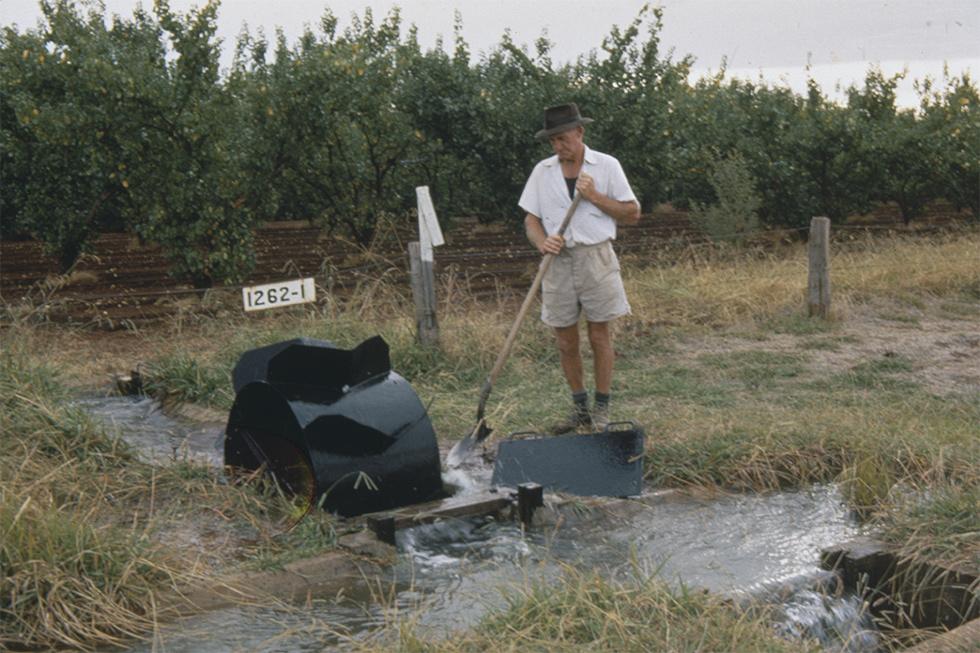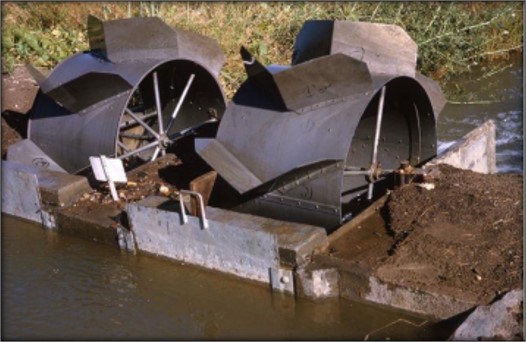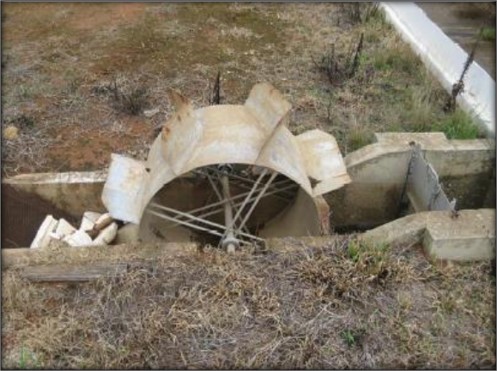Dethridge Outlet/Wheel
Profile; ?>Dethridge outlets/wheels have been used to distribute and measure water onto surface irrigation farms. This simple, robust measuring device has served the irrigation farmers and irrigation water providers of Australia and other countries since 1910. The Dethridge Outlet has generally now been superseded by newer digital technologies for measuring water volumes delivered onto farms and vineyards/orchards, but it played a significant role in the equitable sharing for irrigation of water resources in many countries. At its peak of use, the Victorian State Rivers and Water Supply Commission (SWRWC) estimated that 40,0001 Dethridge wheels were in operation in Australia and elsewhere.
It is highly unlikely that any individual Dethridge Outlet/wheel is over 100 years old, but Dethridge wheels have been used across Australia and many other parts of the world for over 100 years. The steel in the Dethridge wheel was protected by tar, epoxy paints, or galvanising but deteriorated over time and so was replaced by newer wheels. The concrete in the Dethridge Outlet emplacement was often 75 –100 mm thick and would have deteriorated and been replaced. Modernisation programs of irrigation infrastructure have seen these water wheels replaced.
The Dethridge outlet/wheel came in 3 sizes, with the largest of these being the most common. The standard size of the Dethridge outlets/wheel was 5 CFS (cubic feet per second). The second most common was the 2.5 CFS outlet, with both these size wheels used with broad area irrigation. The third size was 1.5 CFS capacity, almost exclusively used in horticulture systems where smaller delivery volumes were required. Farmers often ordered their water for delivery in ‘revs’, with delivery volumes determined by the wheel's number of revolutions over a set time period.
*More details of the structure are available in the attached documents.
The structure was innovative in its ideas at the time of its construction;
At the time of its introduction, the Dethridge outlet/wheel was innovative in that it could measure flow onto the paddock/field from the irrigation channel and hence the volume delivered over a time period. The flow rate was converted to a volume by counting the number of complete revolutions; the wheel undertook as counters attached to a wheel spoke and recorded every revolution. It was simple and robust yet accurate.
The structure contributed to the evolution of efficient and contemporary engineering theories and practices;
The Volumetric measurement of water applied to the farm allowed for charges to be made on a volumetric basis of water use, not just the area irrigated. Accuracy was somewhat independent of flow rate, but generally, it was considered acceptably accurate. The Dethridge outlet/wheel with the Volumetric measurement of water supplied to an irrigation farm enabled equitable sharing of limited water resources via volumetric entitlements of water to farms.
The structure bears the stamp of a cultural tradition or a civilization of past;
The Dethridge Outlet/Wheels were first used in 1910 and hence are more than 100 years old in type. The Dethridge outlet/wheel falls under Scope 3.1 (b) (v) being an ‘old water wheel’ and (viii) structure functionally related to past agricultural water management. The Dethridge outlet/wheel is not seeking classification under list A but is suitable for classification under list B of World Heritage Irrigation Structures. This nomination seeks an archival listing.
Present State of Conservation
The Dethridge outlet/wheel is no longer in general use in Australia due to the legislative requirement for higher levels of accuracy in volume measurement. Although various approaches were taken to improve its accuracy in refining the shape and modifying operating conditions, it did not meet these higher accuracy requirements.
Moves by the Australian National Water Commission to require high-level accuracy (+-5%) of volume measurement significantly contributed to the demise of the Dethridge outlet/wheel as the primary mode of measurement for gravity irrigation systems at the farm level. Automation of structures as part of irrigation infrastructure modernisation also contributed to this demise.
There are presently very few Dethridge outlets/wheels still in operation in Australia. There are, however, various examples of the Dethridge wheel that operate as a reminder and history of the development of irrigation in the Murray Darling Basin and elsewhere. Some of these examples are stationary, while others still turn using a pumped water source. There are also museum examples.
This demise of the Dethridge outlet/wheel as the means of measurement of water being delivered onto farms has led to this nomination seeking recognition of the Dethridge outlet/wheel as a world Heritage Irrigation Structure at this time.
References
Discharge Measurement Structures (Revised Third Edition) International Institute for Land
Reclamation and Improvement Publication 20, 1989 ISBN 9070754510
National Archives of Australia (NAA) – “Dethridge irrigation wheel being used to measure water
flow”
Powerhouse Collection – “Dethridge wheel, irrigation water meter”
“The Dethridge Wheel – 100 years of faithful service”
Peter Fitzgerald (Peter is a former director of Goulburn-Murray Water, the Goulburn-Broken
Catchment Management Authority and is a local irrigator and dairy farmer.)
Pinterest: “The wheel was invented by John Dethridge in Australia in 1910. Dethridge was then
commissioner of the Victorian State Rivers and Water Supply Commission”.
HIGHLIGHTS
Country: Australia
Province: Victoria
Latitude : -36.4434372 Longitude : 145.1345853
Built: 1910
River: Through Australia and various other countries
Basin: Through Australia and various other countries
Sub-Basin: Through Australia and various other countries
Irrigated Area: In excess of 2 million ha
73rd IEC Meeting, Adelaide, Australia, 2022










